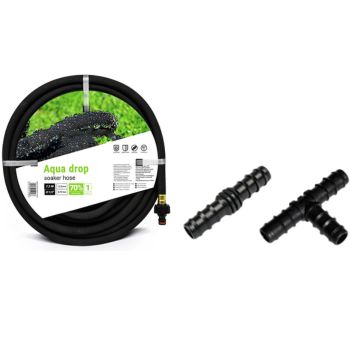
A drip hose ensures that water is slowly released through the pores of the hose. On hot, dry days, a drip hose can be very useful in your garden, as your garden often needs more water. Unlike a regular garden hose, a drip hose provides a continuous release of water in your garden. This means you don't have to fully open the faucet, allowing you to use drinking water more efficiently. With a drip hose, you can water your garden as effectively as possible. The water is gradually distributed to the right places, reducing evaporation compared to the large amount of water released by a regular hose. This ensures that the areas that need water receive a constant supply. In short, a drip hose is a good and economical way to water your piece of land.
You can install a drip hose both above ground and underground. The advantage of installing it underground is that the water cannot evaporate, and this is highly recommended. This can save you up to 50% of water. Ensure that the drip hose is arranged in loops, with 30 to 50 centimeters between them, and that the hose runs right along the roots of the plants you want to water.
Drip hoses are not resistant to frost and severe cold. The hoses do not break in the cold, but it is possible for the holes where the water comes out to freeze shut. Therefore, it is advisable to let all the water flow out of the hose in winter.
An underground drip hose under a hedge is ideal. If it is very dry, turn on the drip hose for half an hour every day. For perennial plants, use a sprinkler that you leave in place for at least an hour.
Like a drip hose, a soaker hose also ensures that water is distributed evenly over the surface. However, there are differences between a drip hose and a soaker hose, especially in terms of water delivery. A soaker hose generally delivers the same amount of water everywhere. With a drip hose, after about 30 meters, the hose delivers less water than in the first 30 meters. A second disadvantage is that if too much dirt gets into the hose, it can break.
There are different types of drip hoses. The main difference between drip hoses is the various lengths of the hoses and the water delivery per hour. You can choose from drip hoses with different water delivery rates, namely 2, 4, or 8 liters per hour. So always choose a drip hose that matches the amount of water your garden needs. In addition, drip hoses are available in various lengths at Techniparts, so you can always find a suitable length that matches the size of your garden.
All our drip hoses have an inner diameter of ½". The lengths offered by Techniparts are 7.5 meters, 15 meters, 25 meters, 50 meters, and 100 meters. Furthermore, Techniparts also sells perforated garden hoses, available in sizes of 15 meters and 7.5 meters. The perforated garden hose sprays fine rain over the entire length of the garden hose. This garden hose comes with Gardena connectors for easy connection to the faucet.
At Techniparts, you can choose from underground drip hoses. These hoses differ primarily in the way they water your garden and in the installation of the irrigation system. The above-ground drip hose is suitable for smaller gardens, and for larger gardens, it is better to choose an underground drip hose. Finally, these hoses differ in the amount of water you can save when using the drip hose. If you want to save more water with your drip hose, it is best to choose an underground drip hose.
Read more here about the differences between both types of drip hoses.
You can install an above-ground drip hose directly in your garden. Above-ground drip hoses are particularly suitable for smaller gardens. This works best if you need to water your ground cover. The advantage of an above-ground drip hose is that you can place it directly in your garden without digging trenches.
In short, choose an above-ground drip hose for smaller areas and when you want to start watering your garden right away!
In contrast to the above-ground drip hose, an underground drip hose is not placed on the surface. By installing your drip hose underground, you can prevent water from evaporating more quickly. With an underground drip hose, you can save up to 50% of water. To install an underground drip hose, you need to dig trenches so that the water can be delivered close to the roots. This not only saves water but also allows for better water absorption. Finally, an underground drip hose does not need to be reconnected every time but can be left in place. Ideal for larger gardens.
In short, choose an underground drip hose if you want to irrigate larger areas and save water.
We supply End Caps, Valves, Connectors, Elbows, T-Junctions, Ground Stakes, and Hose Clamps.
Still didn't find what you were looking for? Feel free to contact our customer service; we are happy to help!
Didn't find the right Drip hoses?
Fill in the form below, and we'll assist you further!
Curious about our blog? Check out all our items here!
Contact us here